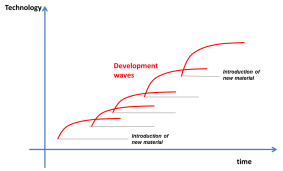Vantablack (from Vertically Aligned Nano Tube Array) absorbs upto 99.965% of all radiation it receives and is now the blackest material known. It is blacker than NASA’s “super-black” (99%) and, I suppose, will be the start of ultra-black.
The uncoated part of this foil remains three-dimensional but the coated part reflects virtually no light and appears flat.
Vantablack is manufactured by Surrey Nano Systems and is already in production.
The Engineer: Vantablack, a so-called ‘super black’ coating from Surrey Nanosystems, combines exceptionally low mass, thermal stability and an ability to absorb 99.96 per cent of incident radiation. Consequently, the coating is suited to applications including apertures, baffles, cold shields and Micro Electro Mechanical Systems (MEMS)–type optical sensors.
The material also overcomes limitations encountered in the manufacture of super-black carbon nanotube-based materials, where high temperatures precluded direct application to sensitive electronics or materials with relatively low melting points. This, along with poor adhesion, prevented their application to space and airborne instrumentation.
There is no established blackness scale. Black paint reflects almost 10% of incident light. Newly laid asphalt reflects 2 – 5% depending upon surface composition. Carbon black (polycrystalline carbon resulting from incomplete combustion) reflects only 1% of incident light. Though we take blackness to be the absence of reflection of radiation, material may reflect radiation at a different wave-length to the incident radiation. All light photons that are absorbed must eventually become heat and all bodies will radiate heat (infra-red) dependent upon only their surface temperature. In physics, a black body is theoretical and absorbs all incident electromagnetic radiation, at all wavelengths and all angles of incidence. In practice such a body can’t exist.
NASA Superblack: NASA engineers have produced a material that absorbs on average more than 99 percent of the ultraviolet, visible, infrared, and far-infrared light that hits it — a development that promises to open new frontiers in space technology. ……
The nanotech-based coating is a thin layer of multi-walled carbon nanotubes, tiny hollow tubes made of pure carbon about 10,000 times thinner than a strand of human hair. They are positioned vertically on various substrate materials much like a shag rug. The team has grown the nanotubes on silicon, silicon nitride, titanium, and stainless steel, materials commonly used in space-based scientific instruments. (To grow carbon nanotubes, Goddard technologist Stephanie Getty applies a catalyst layer of iron to an underlayer on silicon, titanium, and other materials. She then heats the material in an oven to about 1,382 degrees Fahrenheit. While heating, the material is bathed in carbon-containing feedstock gas.)
The tests indicate that the nanotube material is especially useful for a variety of spaceflight applications where observing in multiple wavelength bands is important to scientific discovery. One such application is stray-light suppression. The tiny gaps between the tubes collect and trap background light to prevent it from reflecting off surfaces and interfering with the light that scientists actually want to measure. Because only a small fraction of light reflects off the coating, the human eye and sensitive detectors see the material as black.
In particular, the team found that the material absorbs 99.5 percent of the light in the ultraviolet and visible, dipping to 98 percent in the longer or far-infrared bands. “The advantage over other materials is that our material is from 10 to 100 times more absorbent, depending on the specific wavelength band,” Hagopian said.
Currently, instrument developers apply black paint to baffles and other components to help prevent stray light from ricocheting off surfaces. However, black paints absorb only 90 percent of the light that strikes it. The effect of multiple bounces makes the coating’s overall advantage even larger, potentially resulting in hundreds of times less stray light.
In addition, black paints do not remain black when exposed to cryogenic temperatures. They take on a shiny, slightly silver quality, said Goddard scientist Ed Wollack, who is evaluating the carbon-nanotube material for use as a calibrator on far-infrared-sensing instruments that must operate in super-cold conditions to gather faint far-infrared signals emanating from objects in the very distant universe. If these instruments are not cold, thermal heat generated by the instrument and observatory, will swamp the faint infrared they are designed to collect.











